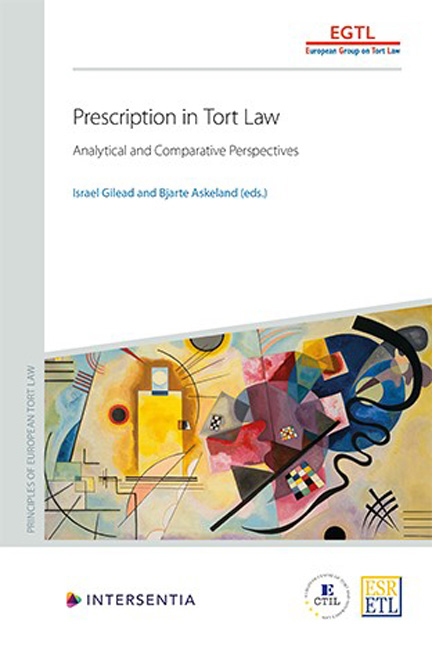Book contents
- Frontmatter
- Dedication
- Acknowledgements
- Contents
- List of Authors
- PART I THEORETICAL AND COMPARATIVE ANALYSES
- Analytical and Comparative Report
- Economic Analysis
- PART II PRESCRIPTION IN TORT LAW OUTLINED
- Case Scenarios
- Austria
- Belgium
- Czech Republic
- England and Wales
- France
- Germany
- Greece
- Italy
- The Netherlands
- Norway
- Poland
- South Africa
- Spain
- Switzerland
- United States
- European Union
- Appendix: Questionnaire
- About the Editors
European Union
Published online by Cambridge University Press: 22 December 2020
- Frontmatter
- Dedication
- Acknowledgements
- Contents
- List of Authors
- PART I THEORETICAL AND COMPARATIVE ANALYSES
- Analytical and Comparative Report
- Economic Analysis
- PART II PRESCRIPTION IN TORT LAW OUTLINED
- Case Scenarios
- Austria
- Belgium
- Czech Republic
- England and Wales
- France
- Germany
- Greece
- Italy
- The Netherlands
- Norway
- Poland
- South Africa
- Spain
- Switzerland
- United States
- European Union
- Appendix: Questionnaire
- About the Editors
Summary
INTRODUCTION
As concerns the issue of limitation periods on claims in tort, there are three dimensions in EU law. First, limitation of claims brought against the EU itself has been regulated. This is the primary subject matter of the present report. Second, in striving to harmonise national laws and ensure the functioning of the common market, the EU enacts directives requiring the implementation of specified regulations into domestic law. At times these directives concern tort law, and make reference in some scope to the issue of limitation periods. Third, the issue of expiry of claims appears in conjunction with the liability of a Member State for damage caused by a violation of EU law; such liability is subject to a mixed set of regulations, both national and European. The second and third issues are the focus of the last fragment of the report.
DEFINITION OF PRESCRIPTION
Expiry of a claim for damages against the EU 1 is regulated in art 46 of the Statute of the Court of Justice of the European Union.
Article 46 Proceedings against the Union in matters arising from non-contractual liability shall be barred after a period of five years from the occurrence of the event giving rise thereto. The period of limitation shall be interrupted if proceedings are instituted before the Court of Justice or if prior to such proceedings an application is made by the aggrieved party to the relevant institution of the Union. In the latter event the proceedings must be instituted within the period of two months provided for in Article 263 of the Treaty on the Functioning of the European Union; the provisions of the second paragraph of Article 265 of the Treaty on the Functioning of the European Union shall apply where appropriate. This Article shall also apply to proceedings against the European Central Bank regarding non-contractual liability.
The Statute constitutes an annex to the treaties in the form of Protocol no 3, and enjoys the status of primary law, setting out the procedure for proceedings before EU courts and the fundamental rules of their functioning.
- Type
- Chapter
- Information
- Prescription in Tort LawAnalytical and Comparative Perspectives, pp. 697 - 726Publisher: IntersentiaPrint publication year: 2020



